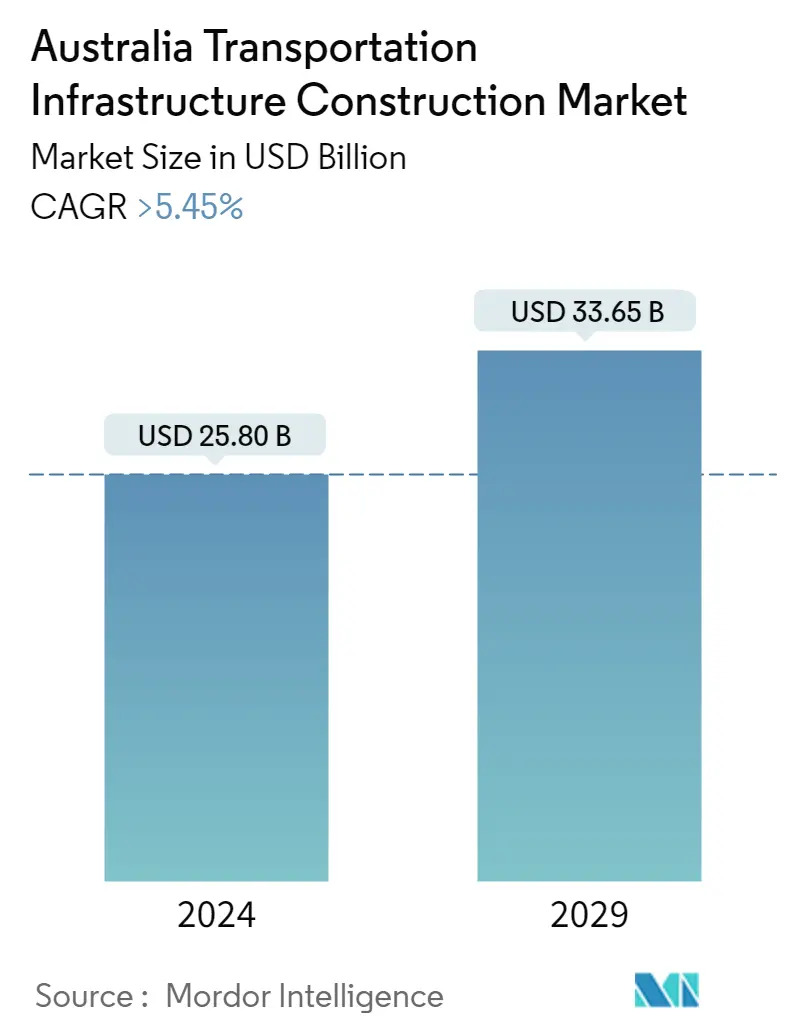Market Size of Australia Transportation Infrastructure Construction Industry

| Study Period | 2020 - 2029 |
| Base Year For Estimation | 2023 |
| Market Size (2024) | USD 25.80 Billion |
| Market Size (2029) | USD 33.65 Billion |
| CAGR (2024 - 2029) | > 5.45 % |
| Market Concentration | Low |
Major Players
*Disclaimer: Major Players sorted in no particular order |
Australia Transportation Infrastructure Construction Market Analysis
The Australia Transportation Infrastructure Construction Market size is estimated at USD 25.80 billion in 2024, and is expected to reach USD 33.65 billion by 2029, growing at a CAGR of greater than 5.45% during the forecast period (2024-2029).
The Australian economy was hit hard by the country's response to the global pandemic, which resulted in lockdowns and regulations. Due to their low cost and excellent efficiency, Australia became more reliant on importing building materials and equipment from elsewhere, mainly China, in the previous 10 years. Manufacturing output and export volume fell sharply in February and March 2020 as enterprises in China were forced to close to avoid the spread of COVID-19. Due to restrictions on people's travel and, in some cases, compulsory business closures to prevent the spread of the disease, suppliers from other regions of the world delayed or ceased industrial output.
In 2021-2022, the Government of Australia announced that the budget included AUD 15.2 billion (USD 11.85 billion) for infrastructure projects over the next 10 years, supporting over 30,000 jobs. This was expected to help the implementation of road, rail, and community infrastructure projects across Australia. The investment comprises AUD 13.2 billion (USD 8.84 Billion) for major infrastructure projects and AUD 2 billion (USD 1.34 Billion) for local projects included under the Road Safety Programme and the Local Roads and Community Infrastructure Programme. Among essential rail projects, the Metronet program in Western Australia and Canberra's Light Rail Stage 2A in the Australian Capital Territory will benefit from the Government's commitment.
The financing is in addition to the Government's significant existing investment in projects that will define the success of local communities for years to come, including the Western Sydney International (Nancy-Bird Walton) Airport, which is due to open in 2026, Sydney Metro Western Sydney Airport and the Melbourne Airport Rail Link. More than 220 major Australian Government-funded projects are currently under construction. With this budget, the Australian Government has provided AUD 170 billion (USD 113 Billion) in funding for the infrastructure since 2013. This funding will support delivering a 10-year AUD 110 billion (USD 85.74 billion) infrastructure investment pipeline and investing in the future.
Australia Transportation Infrastructure Construction Industry Segmentation
The transportation infrastructure construction market includes construction activities for transportation facilities of road, rail, air, and sea ports, which involves reforming existing constructions, building new infrastructures, and extending or demolishing projects.
A complete assessment of the Australian Transportation Infrastructure Construction Market includes an assessment of the economy market overview, market size estimation for key segments, and emerging trends in the market segments in the report. The report sheds light on the market trends like growth factors, restraints, and opportunities in this sector. The competitive landscape of the Australian Transportation Infrastructure Construction Market is depicted through the profiles of active, vital players. The report also covers the impact of COVID-19 on the market and future projections.
Australia's transportation infrastructure construction market is segmented by type (roadways, railways, waterways, and airlines).
The report offers market size and forecasts for the Australian transportation infrastructure construction industry in terms of value (USD) for all the above segments.
| By Type | |
| Roadways | |
| Railways | |
| Waterways | |
| Airways |
Australia Transportation Infrastructure Construction Market Size Summary
The Australian transportation infrastructure construction market is poised for significant growth over the forecast period, driven by substantial government investments and strategic initiatives. The government's commitment to enhancing road, rail, and community infrastructure is evident in its allocation of billions for major projects, including the Metronet program and Canberra's Light Rail Stage 2A. These investments are part of a broader strategy to improve connectivity, reduce congestion, and support economic recovery post-pandemic. The development of key projects such as the Western Sydney International Airport and the Melbourne Airport Rail Link underscores the government's focus on expanding capacity and facilitating smoother freight and passenger movements across the country.
The market landscape is characterized by a mix of local and international players, with companies like CPB Contractors, Lendlease, and John Holland leading the charge. The demand for sustainable and technologically advanced solutions is reshaping the industry, prompting stakeholders to innovate and adapt. Notable projects, such as the Inland Rail, highlight the government's commitment to addressing future freight challenges and supporting population growth. The use of solar-powered signaling systems along the Inland Rail corridor reflects a growing emphasis on sustainability within the sector. As Australia continues to invest in its transportation infrastructure, the market is expected to experience robust expansion, driven by both public funding and private sector involvement.
Australia Transportation Infrastructure Construction Market Size - Table of Contents
-
1. MARKET INSIGHTS AND DYNAMICS
-
1.1 Current Market Scenario
-
1.2 Market Dynamics
-
1.2.1 Drivers
-
1.2.1.1 Investments in Land Transportation Infrastructure
-
1.2.1.2 Development of shipping industry
-
-
1.2.2 Restraints
-
1.2.2.1 High Cost of the projects
-
-
1.2.3 Opportunities
-
1.2.3.1 Strong economic growth in developing countries
-
-
-
1.3 Industry Attractiveness - Porter's Five Forces Analysis
-
1.3.1 Bargaining Power of Suppliers
-
1.3.2 Bargaining Power of Consumers/Buyers
-
1.3.3 Threat of New Entrants
-
1.3.4 Threat of Substitute Products
-
1.3.5 Intensity of Competitive Rivalry
-
-
1.4 Government Regulations and Initiatives
-
1.5 Supply Chain/Value Chain Analysis
-
1.6 Technological Developments in the Logistics Sector
-
1.7 Modernization of the Transportation Infrastructure Sector
-
1.8 Major Infrastructure Development Projects
-
1.9 Impact of COVID-19 on the Market
-
-
2. MARKET SEGMENTATION
-
2.1 By Type
-
2.1.1 Roadways
-
2.1.2 Railways
-
2.1.3 Waterways
-
2.1.4 Airways
-
-
Australia Transportation Infrastructure Construction Market Size FAQs
How big is the Australia Transportation Infrastructure Construction Market?
The Australia Transportation Infrastructure Construction Market size is expected to reach USD 25.80 billion in 2024 and grow at a CAGR of greater than 5.45% to reach USD 33.65 billion by 2029.
What is the current Australia Transportation Infrastructure Construction Market size?
In 2024, the Australia Transportation Infrastructure Construction Market size is expected to reach USD 25.80 billion.

